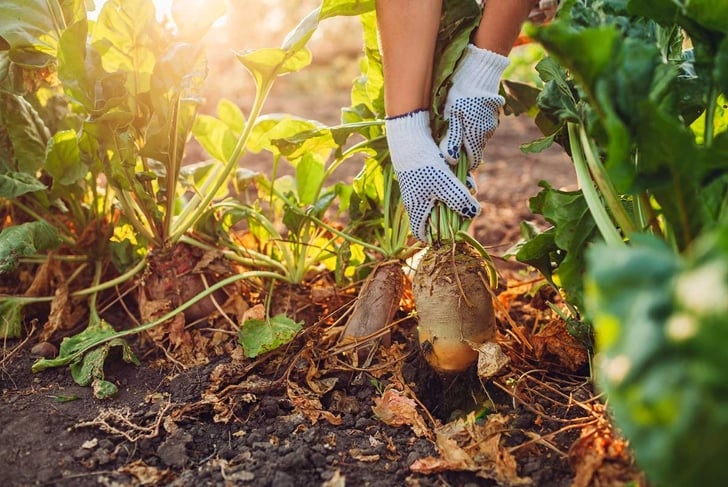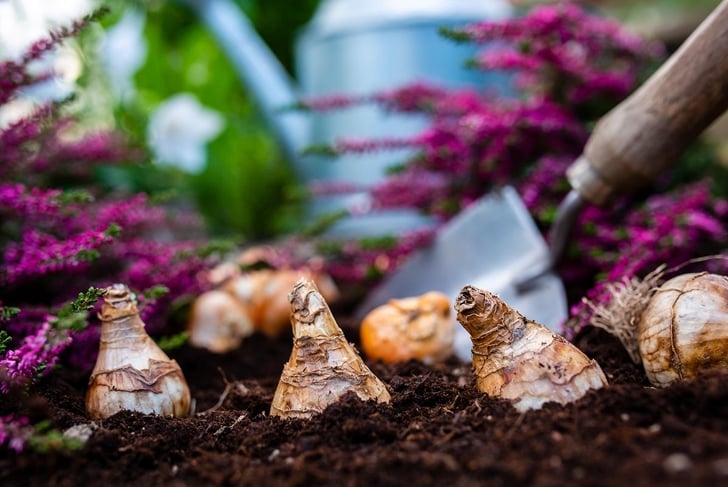
Now that we are past the peak of summer, the days are getting shorter, and the temperatures are slowly dropping. Just because fall is around the corner doesn’t mean you have to say goodbye to your gardening until spring. In fact, there are a few actions you can take that will get your garden ready for fall—and primed for spring planting.
Out with the old

Trim back perennials that have gone dormant and remove all dead plants and annuals. Add these bits to your compost pile for next season, but make sure you put any diseased foliage in a separate trash bin so that it doesn’t reinfect your plants next season. Consider leaving fallen leaves for pollinators and other wildlife through the cold winter.
In with the new D

Plant your spring-flowering bulbs, such as hyacinths, crocus, tulips, and daffodils. And don’t forget about the edible bulbs, such as garlic and perennial walking onions. Depending on your growing zone, the best time to plant bulbs is mid-October to mid-November, before the ground freezes. Add a layer of mulch to the planting area to protect the bulbs.
Share the wealth

Divide perennials and split them into containers to either replant in other areas of the garden or share with others. Divisions need to be replanted in early fall so that the roots are established by winter. Make sure to add a layer of mulch for extra protection.
Stay hydrated

The hottest part of the year may be behind us, but your plants still need plenty of water. This is especially true if your area has been experiencing a drought. A soaker hose or a drip irrigation system every seven to 10 days is better than setting out a sprinkler every other day.
Make sure conifers (pines, firs, spruce, and cedars) and broad-leaved evergreens (boxwood and rhododendrons) are well hydrated throughout the fall before the ground freezes.
Add a protective layer

Put a layer of mulch in garden beds to protect bulbs, trees, and shrubs. Mulch not only helps retain moisture, but also protects roots from extreme winter temperatures. Fall is also a great time to turn the soil and add a layer of compost to your vegetable garden.
Give some support

We all need a little support from time to time, and young plants are no different. Young and newly planted trees need to be staked, especially if you live in an area that is prone to high winds or heavy snow.
To protect the tender bark, run a section of wire through a rubber hose before securing the tree to the stake. You can also use vinyl wrap to protect the bark from rabbits and other animals during the winter months.
Tidy up

Fall is a great time to clean and care for your gardening tools before storing them for the season. Clean off any dirt and let them dry completely. A thin coat of oil, like vegetable oil, can keep them from rusting while in storage. Sharpen any tools that have gone dull so that they are primed and ready for spring gardening. Finally, hang or store all gardening tools and equipment so that they are out of the elements.
Start a collection

If you have some favorite annuals or perennials from the season, save their seeds to plant for next year. They are also great for swapping with other gardeners or gifting to friends and family. To save seeds, place them in a paper envelope or bag and store them in a cool, dry place. If you’re concerned about moisture or pests, place them in a clean, sealable glass jar.
Take advantage of sales

The end of summer is a great time to buy trees, shrubs, bulbs, and perennials on sale. Nurseries want to clear out their summer stock to make room for fall plants and holiday goods. So, look at your garden and evaluate what you’re missing or what you want more of. Then, go buy it at a steep discount.
Keep it growing

Fall is a great time to start a fall crop and plant trees and shrubs. If you’re wanting to expand your growing area, take advantage of the cooler temperatures for building raised beds or hauling soil. For fall harvest, plant crops like broccoli, kale, lettuce, parsnips, collards, Brussels sprouts, beets, turnips, and radishes. And, of course, no fall garden would be complete without pumpkins and squash.
To keep your garden happy, healthy, and producing all year round, take care to transition it from summer to fall. Check your local growing season to see what works best where you live.





